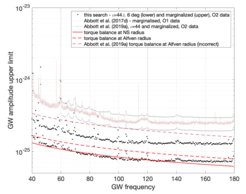Probing Sco X-1 with gravitational waves
Studying a neutron star in an entirely new way
Sco X-1 is a low-mass X-ray binary, i.e. a neutron star in orbit with a companion star from which it also accretes matter. If the neutron star is non-axisymmetrically deformed, e.g. by uneven accretion of matter onto its surface, it will emit continuous gravitational waves. Using public LIGO O2 data, the authors were able for the first time to test for the presence of continuous gravitational waves at amplitudes corresponding to the accretion torque. While no signal was found, their upper limits allow them to probe the mass, the radius, and the magnetic field of the neutron star in an entirely new way.
Paper abstract

We present the results of a search in LIGO O2 public data for continuous gravitational waves from the neutron star in the low-mass X-ray binary Scorpius X-1. We search for signals with ≈ constant frequency in the range 40-180 Hz. Thanks to the efficiency of our search pipeline we can use a long coherence time and achieve unprecedented sensitivity, significantly improving on existing results. This is the first search that has been able to probe gravitational wave amplitudes that could balance the accretion torque at the neutron star radius. Our search excludes emission at this level between 67.5 Hz and 131.5 Hz, for an inclination angle 44° ± 6° derived from radio observations (Fomalont et al. 2001), and assuming that the spin axis is perpendicular to the orbital plane. If the torque arm is ≈ 26 km – a conservative estimate of the Alfvén radius – our results are more constraining than the indirect limit across the band. This allows us to exclude certain mass-radius combinations and to place upper limits on the strength of the star’s magnetic field with a different probe than ever used before. We also correct a mistake that appears in the literature in the equation that gives the gravitational wave amplitude at the torque balance (Abbott et al. 2017b, 2019a) and we re-interpret the associated latest LIGO/Virgo results in light of this.












